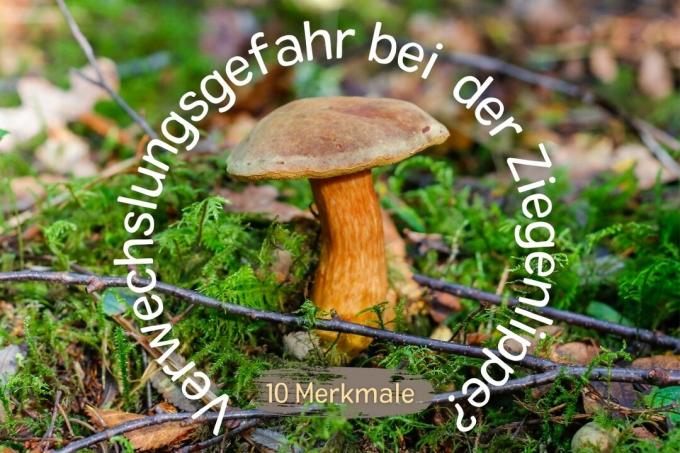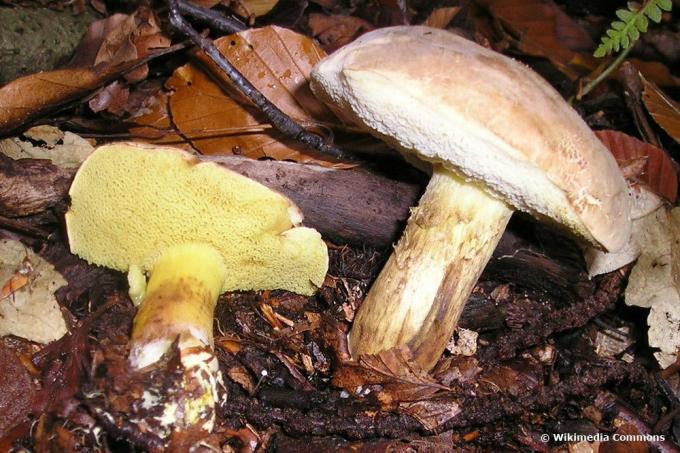
table of contents
- Locations and distribution
- Growing time
- colour
- Grain
- size
- cap
- Tubes
- stalk
- meat
- Likelihood of confusion
- frequently asked Questions
The goat lip mushroom is edible and tasty, but there is a risk of confusion with other varieties. Here you can find out what unique characteristics are and how you can recognize Xerocomus subtomentosus.
In a nutshell
- the hat is three to ten centimeters in diameter
- felt-like, velvety covering
- large variety of colors
- the hat hardly tears
- strong upholstery available
Locations and distribution
In Europe, the mushrooms are more common in southern and thus warm regions. The goat lip is less common in the north. As a result, you will find yourself in the forest in warm and sunny places. That means:
- Clearings
- Edge of the undergrowth
- ways
The mushrooms can also be found along the edge of the forest. This peculiarity alone can help to distinguish it from other varieties.

Forest art
The goat lip belongs to the mycorrhizal fungi and grows mainly in red beech forests. However, it can also be collected in woodruff and woodruff beech forests.
Occurrence in:
- Oak-hornbeam forests
- Spruce-fir forests with acidic soil
- Gardens
- artificially created spruce forests
- Parks
Growing time
The fungi occur mainly between summer and autumn. An occurrence in spring can only be expected in the south and in very warm regions. The wedding is between July and October.
Note: The goat lip grows mainly solitary. Loose groups can also occur.
colour
With the variety of color variations, it can be difficult to differentiate. Because the goat lip can have several tints and these can change over time. However, you can orientate yourself on a spectrum. This applies to both the stem and the hat.
- brownish
- yellow
- olive green

Note: The colors can merge into one another. With small mushrooms they are more intense. In older specimens, they will fade and appear paler as a result.
Grain
Unique features also include the drawing of the mushroom hats. Here, web-like drawings stand out in particular. These arise from veins and flakes. Instead of a network, lines can also appear, which usually appear reddish.
size
The size and dimensions are not unambiguous features that prevent the risk of confusion. However, they can still provide an orientation.
- Height from three to eight centimeters
- Thickness of the stem between five and 20 millimeters
- The diameter of the hat is three to eight centimeters
cap
In the case of smaller specimens of the goat lips, the hat is smooth and padded. Over time, the pad will get a little smaller. But the hat never becomes completely flat. It is also noticeable that hardly any cracks form on the edges. It is also felty to velvety and can be compared to the skin of a peach.
Tubes
In contrast to other mushrooms, there are no lamellae on the underside of the hat, but tubes. In young specimens of the goat's lip, these are comparatively small. However, the older the fungus gets, the bigger they get. The surface appears open-pored and like a sponge. The underside is colored yellow.
stalk
The stem of the goat lip is light yellow to brownish-yellow. The color below is generally lighter and darkens towards the top. The surface is rarely completely smooth. Often there are grooves and veins as well as flakes on the stems. Further characteristics are:
- tapers upwards
- stable
- cylindrical
meat
Inside the mushroom, the color is exactly the opposite of the shade of the stem on the outside and the hat. Because the flesh is ocher-yellow to red-brown at the bottom and becomes lighter towards the top. As a distinguishing feature, however, this criterion is only evident when the goat lip is cut off. Another point is noticeable here. Because in the event of injuries or if it is completely cut off, the meat will not discolour or only to a very small extent.

Likelihood of confusion
There is a risk of confusion with different ones other mushrooms, like for example:
- brown mushroom boletus
- Goldröhrling
- Kuhröhrling
- velvety mushroom boletus
- Pine boletus
- Red-footed bolete
- Sandröhrling
frequently asked Questions
The mushrooms have a very mild taste and a subtle aroma. For this reason, they can also be wonderfully combined with other varieties, vegetables or meat and herbs.
The mycelium or the root of the fungus is white to light yellow. This can also be an indication when differentiating from other varieties.
Contact a mushroom advice center. Here you can get further help. This will prevent accidentally eating a dangerous or poisonous specimen.

